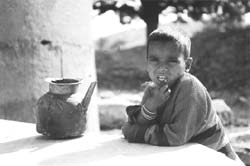On a tightrope
 India's food production managed to keep ahead of population growth, which helped it through some of the most critical drought years like the one in 1979. But the stagnation in agricultural production has once again created despondency. Food production has been unable to keep pace with the booming population.
India's food production managed to keep ahead of population growth, which helped it through some of the most critical drought years like the one in 1979. But the stagnation in agricultural production has once again created despondency. Food production has been unable to keep pace with the booming population.
The total investment in agriculture has decreased from 11.6 per cent of the gross domestic product to 9 per cent in the 1990s. "India has very little land left for agriculture. But the mouths to feed are increasing,' says Michael Vlassoff, United Nations Population Fund representative, India. The available cropland per person has decreased from 0.21 hectares (ha) per person in 1960 to 0.10 ha in 1999. This is expected to plummet to 0.07 ha by 2050, according to the Washington-based Worldwatch Institute (wi).
The trouble does not end here. Indiscriminate pumping of groundwater has led to a decline in the quality and quantity of water. "There are many districts where the water table has gone down by 15 to 20 metres,' says N C Saxena, secretary, Planning Commission. Says K N Sharma, joint secretary for International Commission for Irrigation and Drainage, "We face a very tough time. But the gravity of the situation has to be felt by politicians and bureaucrats.'
According to the International Water Management Institute (IWMI), water pumped from aquifers is twice the amount that is recharged into the aquifers by rainfall. As a result, the water table is falling at the rate of 1-3 metres per year. Two districts in Tamil Nadu and Gujarat have aquifers that are fully depleted. iwmi believes India's harvest will be reduced to by 25 per cent if this goes unchecked. The drinking water scenario is equally bad. Though the ministry of rural development claims 95 per cent of the villages have drinking water, independent reports do not say the same. The disparity between access to potable water between rural and urban households is equally shocking. Only 55.5 per cent of rural households had access to safe water in 1991 against 81.4 per cent in urban areas.
